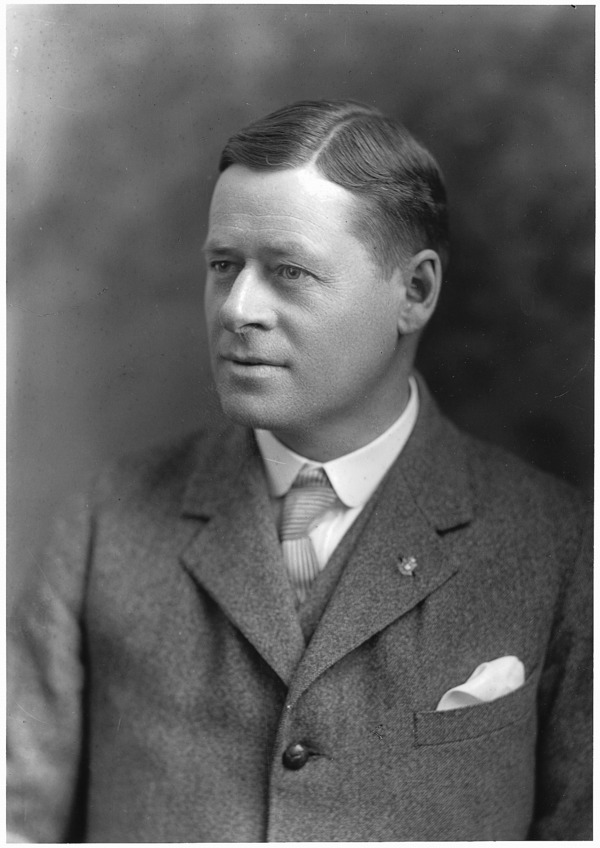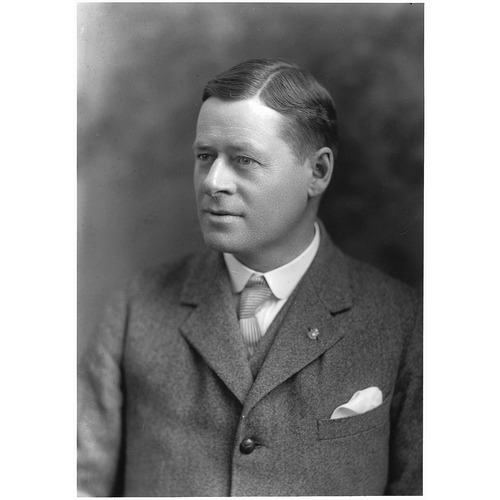
Source: Link
FORBES, ALEXANDER MACKENZIE TORRANCE, orthopaedic and paediatric surgeon, professor of surgery, and army officer; b. 21 Dec. 1874 in Montreal, son of Alexander MacKenzie Forbes, an insurance agent, and Elizabeth Fisher Torrance; m. there 9 Nov. 1912 Henrietta Muriel Coristine, widow of Dr Howard M. Church, and they had one daughter; d. there 16 May 1929.
MacKenzie Forbes’s mother came from a prominent Montreal family that included her grandfather John Torrance* and her cousin David*. After attending the High School of Montreal, Forbes entered McGill University in 1890 at age 15. In 1894 he enrolled in McGill’s faculty of medicine, from which he graduated with honours in 1898. Later that year, on 18 September, he obtained his licence to practice. He then worked, probably for a year, as a government physician on the French Shore of Newfoundland and visited Wilfred Thomason Grenfell*’s mission in Labrador, where he saw so many children with bone, foot, and lower limb deformities that he became interested in orthopaedic surgery. He received training in orthopaedics in New York City at the Hospital for the Ruptured and Crippled as a house officer. After returning to Montreal in 1902, he was appointed assistant demonstrator in anatomy at McGill.
Because they had no hospital admitting or operating privileges, Forbes and a group of friends met on 25 Nov. 1902 and decided to open a children’s hospital in Montreal where they could treat orthopaedic disease. By November 1903 a building had been rented and converted into a hospital with 10 beds. Francis John Shepherd, Alexander Dougall Blackader*, Harold Beveridge Cushing, Robert Tait McKenzie*, and Forbes formed the medical staff. The Children’s Memorial Hospital admitted its first patients in January 1904 and can be considered one of the first institutions in Canada devoted to the treatment of children’s orthopaedic diseases.
Forbes was chief of surgery at Children’s Memorial and he operated on many types of orthopaedic deformities. Typical operations dealt with club feet, tuberculosis of the spine, scoliosis, the complications of spina bifida, spastic dipligia, defects from osteomyelitis, deformities of spine and limbs from poliomyelitis, torticollis, bowed legs, birth defects of the arms and legs, Volkmann’s ischaemic contractures (reflex sympathetic dystrophy), and trauma. He set fractures, reduced dislocations, repaired cleft palates, transplanted tendons, and applied spica plaster splints to the hips, feet, and spine. He was finally given in-patient operating privileges at the Montreal General Hospital in 1906 and was appointed orthopaedic surgeon to the hospital the same year.
After two years, the children’s hospital desperately needed to move. Admissions continued to increase and in many cases hospital stay was prolonged because Forbes and the other doctors treated increasingly complex deformities. A new site was chosen on the southwest side of Mount Royal on Cedar Avenue. Money was raised to purchase the land and construct the new hospital in 1907 and the doors opened in 1909. Forbes, who took an interest in every aspect of the hospital’s administration, was chief of the hospital and surgical services and Cushing was chief of medicine.
Meanwhile, Forbes had continued to lecture at McGill as demonstrator in anatomy during 1907–9 and as assistant demonstrator in orthopaedic surgery for 1908–10. In 1911 he was appointed the first chief of orthopaedics at the Montreal General. Despite this new appointment, he was named only a lecturer in orthopaedics at McGill the following year; he would hold that post until 1920.
At the outset of World War I Forbes volunteered for military service. In the fall of 1914 he was sent to Valcartier, near Quebec City, to begin training at the newly established No.1 Canadian General Hospital. After eight days at Valcartier he departed with the hospital for Salisbury Plain, England. Although he had no training in psychiatry, Forbes, a captain, had the unpleasant duty of interviewing soldiers who were thought to be unfit for service for psychiatric reasons. He was temporarily commissioned major on 17 April 1915 and the following month his unit went to Boulogne, France. In a tent hospital Forbes and a few other surgeons treated wounds with a quantity of tissue destruction and sepsis never imagined in Montreal. With experience the staff changed its procedures and septic wounds were scrubbed and drained and the majority of the wounded survived. In July 1915 1,065 patients were admitted, 617 of them were wounded, 335 were operated on, and 26 died from wounds. By November 1915, of the 1,993 admissions, 470 were wounded, 321 were operated on, and only 15 died from wounds, a remarkable record. McGill University tried to send its surgeons to the front on rotation, so in December 1915 Forbes was recalled to Canada for military duty; he was discharged on 30 June 1917 and returned to his work in paediatric orthopaedics. After the war he served on the national executive of the Great War Veterans’ Association of Canada.
The prolonged hospitalization and rehabilitation of many school-aged patients that Forbes and other surgeons treated created educational problems for the children. The initial solution was to hire a teacher for the children’s hospital. Awareness of the problem also led to a greater concern about the education of those crippled children in Montreal who could not attend regular schools and who were not hospitalized. Forbes and his associates thus founded the School for Crippled Children on Cedar Avenue, east of the children’s hospital. It opened in 1914 with a few children who were transported to and from the school in hospital ambulances; by the end of the first year almost 100 children were enrolled. Forbes would remain a director until his death.
Forbes’s excellent work led to his appointment as clinical professor of orthopaedics at McGill in 1922 and it attracted the attention of the Shriners, a North American fraternity interested in helping crippled children. On Cedar Avenue between the Children’s Memorial Hospital and the School for Crippled Children, they established the Shriners Hospital for Crippled Children – Montreal Unit, the 10th in their system of orthopaedic hospitals in North America. It was opened on 18 Feb. 1925. Forbes had been appointed its first chief of orthopaedics on 19 April 1924 and served in this position until he died. Operations by Forbes and other surgeons on indigent crippled children from all over Canada were paid for by the Shriners.
MacKenzie Forbes had been elected to the American Orthopaedic Association in 1908 and became its president in 1928. He was president of the Montreal Medico-Chirurgical Society in 1919. He wrote papers on orthopaedic cases and developed a complicated device for treating scoliosis which was never successful. At the peak of his career he developed myocarditis and died suddenly from this disease in Montreal at age 54. He had made significant contributions to paediatric orthopaedic surgery, to the foundation of two hospitals, and to the organization of educational services for crippled children.
Alexander MacKenzie Torrance Forbes is the author of “A case of lues venerea with an unusually protracted incubation period,” Montreal Medical Journal, 28 (1899): 942–43; “Notes on the etiology and pathology of catheter fever: with the results of an investigation as to the prophylactic treatment,” Montreal Medical Journal, 28: 333–38; Reconstructive surgery in peace based on orthopaedic surgery in war (Philadelphia, 1919); Soldier and the land: vice-president of Great War Veterans’ Association points to need of a new national policy for Canada ([Winnipeg, 1919?]); Canada in 1920 ([Montreal, 1920?]); and Essays and lectures on clinical surgery ([Philadelphia], 1922).
ANQ-M, CE601-S68, 17 mars 1875. BCM-G, RBMB, St George’s (Anglican) Church (Montreal), 9 Nov. 1912. LAC, RG 150, Acc. 1992-93/166, box 3178. Shriners Hospitals for Children – Canada (Montreal), Admissions book, 1925-44; Record of operations, 1925–44. W. H. Atherton, Montreal, 1534–1914 (3v., Montreal, 1914). Kenneth Cameron, History of No.1 General Hospital, Canadian Expeditionary Force . . . 1914–1919 (Sackville, N.B., 1938). Canadian Medical Assoc., Journal (Toronto), 21 (1929): 109. L. M. Kruger and S. R. LaForte, Chiefs of staff, then and now: a history of the chiefs of Shriners Hospitals for Crippled Children, 1922–1994 ([Springfield, Mass., 1994?]). H. E. MacDermot, “Dr. Mackenzie Forbes and his hospital,” McGill News (Montreal), 27, no.2 (spring 1956): 35, 62. McGill Univ., Faculty of medicine, Calendar (Montreal), 1922. Montreal General Hospital, Annual report, 1911–12. J. B. Scriver, The Montreal Children’s Hospital: years of growth (Montreal, 1979). The storied province of Quebec; past and present, ed. W. [C. H.] Wood et al. (5v., Toronto, 1931–32).
Cite This Article
Joseph Hanaway, “FORBES, ALEXANDER MACKENZIE TORRANCE,” in Dictionary of Canadian Biography, vol. 15, University of Toronto/Université Laval, 2003–, accessed January 1, 2026, https://www.biographi.ca/en/bio/forbes_alexander_mackenzie_torrance_15E.html.
The citation above shows the format for footnotes and endnotes according to the Chicago manual of style (16th edition). Information to be used in other citation formats:
| Permalink: | https://www.biographi.ca/en/bio/forbes_alexander_mackenzie_torrance_15E.html |
| Author of Article: | Joseph Hanaway |
| Title of Article: | FORBES, ALEXANDER MACKENZIE TORRANCE |
| Publication Name: | Dictionary of Canadian Biography, vol. 15 |
| Publisher: | University of Toronto/Université Laval |
| Year of publication: | 2005 |
| Year of revision: | 2005 |
| Access Date: | January 1, 2026 |



